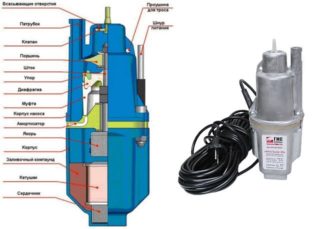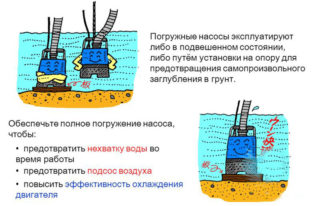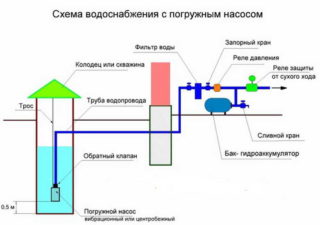In the autonomous water supply system at a summer cottage or in a private house, there is a submersible pump that delivers water to the surface of the earth. The main difference between submersible pumps from other varieties is full penetration into the liquid. To protect the electric motor and reduce the risk of overheating, the operating mechanism is designed in a special way.
Purpose and scope of submersible pumps

Submersible equipment is used for pumping any liquid - drinking or dirty water, feces, corrosive liquids in chemical production systems. The requirements for each variety are fundamentally different:
- To lift water from a sand well, it is necessary to protect the mechanism from the ingress of large particles. Sand or stones can damage the surface of parts, the device will quickly fail.
- The depth of an artesian well requires a greater height of the water column, so the main criterion here will be power.
- Fecal submersible mechanisms are equipped with special grinders, which, when pumped, form a homogeneous mass.
- Water intake from the well is carried out by a submersible mechanism with a float.
- If there is a fountain in the design of the site, it is also served by a deep pump, creating the required pressure in the system.
- For watering the garden, it is possible to use river water, which is at some distance from the house. In this case, filters must be installed on the equipment.
- Lawn sprinklers also require constant pressure, so a small pump will do.
- For industrial purposes, submersible equipment is used for the extraction of mineral water, the delivery of sea water or the extraction of minerals in the mining industry. These types of pumps must be protected against corrosion so that they can be used for a long time. The same applies to the chemical industry, where acids, alkalis, and alcohol-containing substances are pumped through the device.
As a type of submersible pump, you can call hand equipment that is not connected to electricity and works from the use of hand force.
Types of submersible pumps for water
- vibrating;
- centrifugal;
- screw.
Vibration pumps are the most reliable and durable because they do not have rotating and moving mechanisms that often break. The principle of operation of vibration equipment is based on the movement of the diaphragm, which bends under the influence of a magnetic field. In this case, water is taken from the reservoir. Then the diaphragm returns to its original position, while the valve closes and the liquid enters the pipe.
The disadvantage of vibration pumps is their sensitivity to voltage drops. If it is reduced by at least 10%, the power can be halved. Together with the equipment, it is advisable to purchase a stabilizer that will regulate the voltage.
The advantage of vibration pumps is that they overheat a little and rarely break, therefore they are popular with summer residents.
Centrifugal pumps have proven themselves well in narrow wells with a diameter of 12 cm or more. The principle of operation is based on the action of a rotating shaft, on which there are blades and wheels. The shaft creates a motion in which centrifugal force pushes the liquid to the surface.
Centrifugal devices can be single-stage and multi-stage. The latter are capable of creating more pressure. There are self-priming devices that start working when the body is filled with air. A type of centrifugal self-priming pump is a vortex and liquid ring type. Vortex ones do not work for a long time in dirty water, and liquid-ring ones are used where there is a large amount of dissolved air, that is, the pumped water is not homogeneous.
Pumps with a normal suction installation cannot start until the casing and the discharge pipe are filled with water. If this is not done, the internal mechanism will become unusable and will not be able to pump water. A damaged, leaking hose can interfere with the operation of the unit. It is recommended to use a spiral one, as it is more resistant to cracks and creases.
Screw (auger) devices are not capable of working at great depths. The limit for them is 15 meters, so the area of use is limited by the depth of the well. The disadvantage is low power, therefore, to provide water to a private house, you will need to choose an expensive and powerful unit. The device of the screw pump is simple, so it serves for a long time. However, the water from the sand well is supplied with admixtures of stones and mud.
Advantages and disadvantages
- minimum noise level due to water absorption capacity;
- do not freeze, since the water temperature does not drop below zero;
- all internal parts are cooled by the surrounding liquid, so they do not overheat;
- high-performance equipment is used for artesian deep wells.
The disadvantages are present primarily in the installation: not all submersible pumps can be installed in deep wells. The design of the unit matters. Some of them - vibration ones - lead to rapid siltation of the pipe, since the principle of operation raises mud from the bottom of the well, and subsequently it settles on the walls.
When installing the device, it is required to protect the electrical cable so that a short circuit does not occur. For routine maintenance, the tool must be removed from the well - this may require specialist assistance. In some cases, when the well is too narrow, the submersible pump can get stuck inside, which will require additional work.
Criterias of choice
In order to choose the right pumping equipment for a well or well, it is necessary to take into account the following parameters:
- Casing dimensions to match the pump diameter.
- Well depth. These data are indicated in the documentation that is left by specialized teams.
- Measure static and dynamic water levels. Dynamic is the distance from the bottom to the surface of the water. Static - from the mirror of the water to the surface of the earth. Data is collected after a two-day pause in pumping.
- To determine the height of the water column, which is also a selection criterion, the static level value is subtracted from the total well depth.
- System pressure. For the system to function normally, 3 atmospheres is enough, but losses are observed when water passes through the pipes, as well as in the connecting nodes and valves.
- Performance. To do this, you need to calculate the daily need for a house and a site in liquid.
- The purity of the water. Some models break quickly if solid particles are present in the liquid.
- The presence of additional devices, for example, a float, a coarse filter or a voltage stabilizer. This will help to operate the pumping equipment longer without the need for repairs.
- Manufacturer's brand and its cost.
If the liquid contains gases, this must be reported at the time of purchase in order to choose a submersible centrifugal pump that is capable of working with water of this quality.This applies primarily to mineral springs with natural gas levels.
Installation and connection steps
You can prepare the equipment yourself, having previously studied the procedure:
- A pipe is attached to the outlet. The joint is additionally wrapped with tow or a special tape. This is to maintain a vacuum and prevent leaks that cause equipment to wear out.
- A hose and a non-return valve are attached to the suction part. It prevents the water from draining.
- A coarse filter is attached to the end of the valve so that sand does not get into the pump housing and does not create friction.
- The electrical cable is fastened to the pumping element with clips.
- The nylon thread, which will hold the pump in the well, is tied to brackets.
- The unit is lowered down to the required level and fixed in this position at the top. Usually, 1 meter is left from the bottom so that when water is consumed, an idle situation does not arise.
The most common mistakes made by non-professionals are the incorrectly selected cable cross-section that does not correspond to the pump power, as well as the absence of a backflow valve. Incorrect determination of the water level can lead to rapid damage from overheating of the unit and increased friction of parts without liquid. If there are constant power surges in the home, this can lead to a loss of power and poor water flow into the system. For this, a stabilizer or storage tank is installed.
It is not recommended to save on water supply for several reasons. One of them is constant renovation and lack of water in the house. The most popular equipment is imported. The price of a 12 volt electric water pump for a home well of foreign brands is about 25 thousand rubles. The service life of such a device is up to 10 years without the need for repair.











